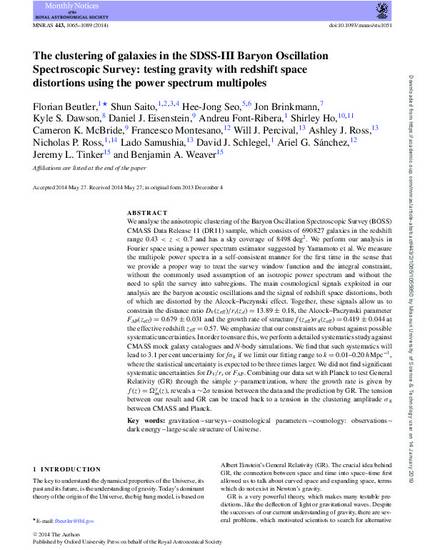
We analyse the anisotropic clustering of the Baryon Oscillation Spectroscopic Survey (BOSS) CMASS Data Release 11 (DR11) sample, which consists of 690 827 galaxies in the redshift range 0.43 < z < 0.7 and has a sky coverage of 8498 deg2. We perform our analysis in Fourier space using a power spectrum estimator suggested by Yamamoto et al. We measure the multipole power spectra in a self-consistent manner for the first time in the sense that we provide a proper way to treat the survey window function and the integral constraint, without the commonly used assumption of an isotropic power spectrum and without the need to split the survey into subregions. The main cosmological signals exploited in our analysis are the baryon acoustic oscillations and the signal of redshift space distortions, both of which are distorted by the Alcock-Paczynski effect. Together, these signals allow us to constrain the distance ratio DV(zeff)/rs(zd) = 13.89 ± 0.18, the Alcock-Paczynski parameter FAP(zeff) = 0.679 ± 0.031 and the growth rate of structure f(zeff)σ8(zeff) = 0.419 ± 0.044 at the effective redshift zeff = 0.57. We emphasize that our constraints are robust against possible systematic uncertainties. In order to ensure this, we perform a detailed systematics study against CMASS mock galaxy catalogues and N-body simulations. We find that such systematics will lead to 3.1 per cent uncertainty for σ8 if we limit our fitting range to k = 0.01-0.20 h Mpc-1, where the statistical uncertainty is expected to be three times larger. We did not find significant systematic uncertainties for DV/rs or FAP. Combining our data set with Planck to test General Relativity (GR) through the simple γ-parametrization, where the growth rate is given by f (z) = Ωγm m(z), reveals a ~2σ tension between the data and the prediction by GR. The tension between our result and GR can be traced back to a tension in the clustering amplitude σ8 between CMASS and Planck.
- Cosmological parameters,
- Cosmology: observations,
- Dark energy,
- Gravitation,
- Large-scale structure of universe,
- Surveys
Available at: http://works.bepress.com/shun-saito/38/
